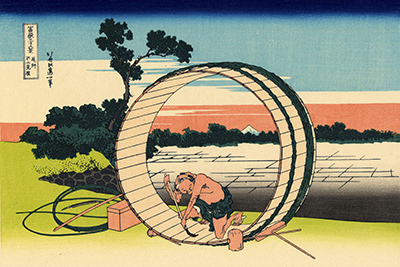Fuji View Plain in Owari Province or Bishû Fujimi-ga-hara, is a print form the famous Katsushika Hokusai's series Thirty-six Views of Mount Fuji also known as Fugaku sanjûrokkei. The volcano Mount Fuji has been fascinating the Japanese history for centuries. Historians and artists alike have had a lot to say and depict about the Mount Fuji.
Hokusai was very possessed with the tradition of immortality that was associated with the Mount Fuji that he decided to produce the Thirty-Six Views of Mount Fuji series that has several prints including the Fuji View Plain In Owari Province. The print depicts a man engaged in an activity, and the background has been produced in such a manner that it looks like a theatrical stage. He seems to have experimented a lot with the Eastern tradition and Western techniques in this painting.
Ukiyo-e artist Katsushika Hokusai (1960-1849) is was trying to depict different seasons, weathers, and conditions of the Mount Fuji series that was published by a Japanese publisher known as Nishimuraya Yohachi. The indisputable colour-print masterpiece of the Fuji View Plain in Owari Province artwork is outstanding. The artwork was done by Hokusai when he was in his seventies around the Edo Period between 1830 and 1831.
Katsushika Hokusai is one of the ancient artists in the Asian history who was believed to have had the most number of names. Although it was a norm for artists of the Edo Period to have several pseudonyms, Hokusai's several names depicted popularity and success among his peers. Hokusai was inspired by various painting styles like the Sesshu Toyo among other Chinese styles when he became a printmaker of the Edo Period. It’s believed that his mother may have been a concubine to his farther and perhaps that is the reason why he was never an heir to his farther Nakajima Ise who was a mirror maker and a partial painter. When Hokusai joined the Tawaraya School and adopted the name the Tawaraya Son, he started producing lots of brush paintings called Surimono. The first time he adopted the name Hokusai Tomiso was in 1798 when he started painting as an independent artist.




